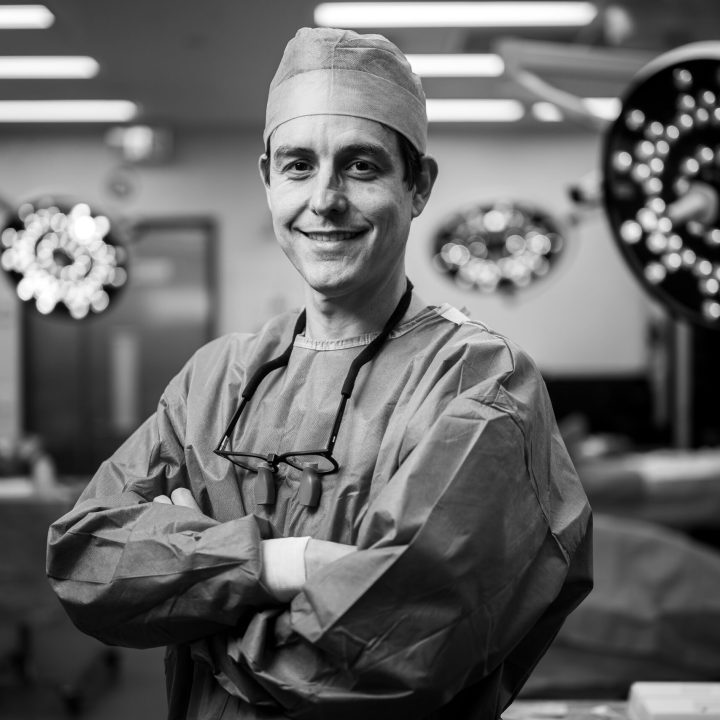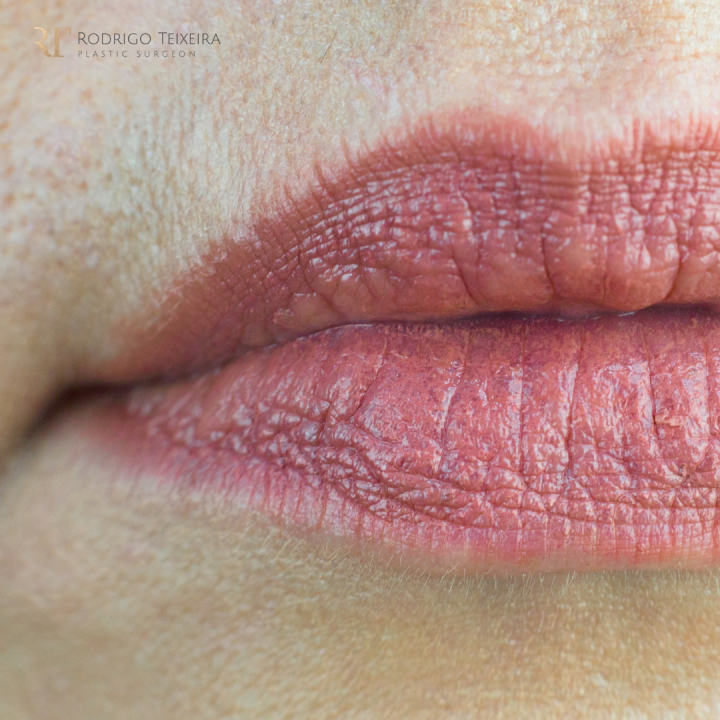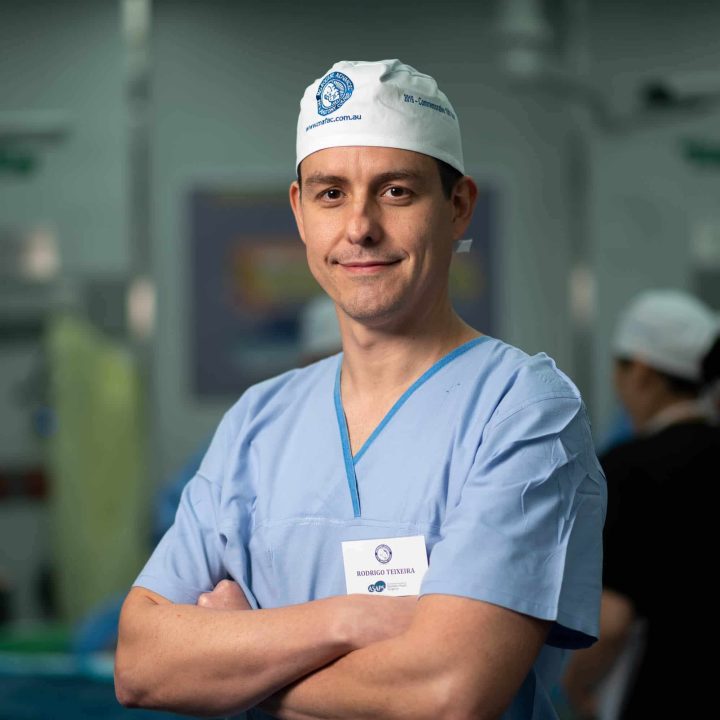Meloplasty (Facelift Surgery) Melbourne
Dr Rodrigo Teixeira offers meloplasty (facelift surgery) in Melbourne, using the deep plane technique to reposition facial structures, refine definition, and achieve outcomes that align with each patient’s natural anatomy.
What is a Meloplasty (Facelift) ?
Meloplasty, the medical term for facelift surgery, involves carefully placed incisions around the hairline and ears to ensure the scars are discreet as possible. These incisions provide access to the underlying facial structures, allowing for the lifting and repositioning of tissues, tightening of muscles, and removal of excess skin.
A key part of modern facelift surgery is addressing the SMAS (Superficial Musculo-Aponeurotic System), a layer of connective tissue and muscle that supports the facial structure. By releasing specific facial ligaments and repositioning the SMAS layer, the face can be lifted in a way that restores youthful contours and smooths folds and wrinkles, all while avoiding a “pulled” appearance.
There are several types of meloplasty facelift techniques, each tailored to different stages of facial ageing and patient goals. Dr Rodrigo Teixeira, a Specialist Plastic Surgeon based in Melbourne, has a particular focus on the Deep Plane Facelift technique. This method lifts the tissue layers in a deeper plane for to restore facial support and achieve a refreshed appearance that aligns with the patient’s features.
At Unveil Plastic Surgery in Melbourne, we understand that each patient is different, so we tailor our facelift procedures to individual requirements whilst focusing on safety.
Our Facelift (Meloplasty) Techniques
Short-Scar Meloplasty (Mini Facelift)
The short scar meloplasty, also known as a mini facelift, is designed to minimise visible scarring by using smaller, strategically placed incisions—typically around the ears. It is well suited to individuals showing milder signs of facial ageing and minimal skin excess who are seeking a subtle yet refreshed appearance.
This technique can be performed under either local or general anaesthesia, depending on the extent of the procedure and patient preference. On average, a short scar meloplasty takes approximately three hours to complete.
SMAS Lift and Advanced SMAS Facelift Technique
Advanced meloplasty techniques such as SMAS lift and deep plane facelift involve surgical dissection beneath the skin and fat layers to access the supportive tissue known as the SMAS (Superficial Musculo-Aponeurotic System). This layer plays a critical role in facial ageing and is a key focus in modern facelift surgery.
By lifting, reshaping, and securing the SMAS and surrounding facial structures, these techniques can provide more durable results. Variations such as limited SMAS, extended SMAS, and high SMAS differ in the extent of dissection and the direction in which tissues are repositioned. These approaches are selected based on the patient’s anatomy and desired outcome and are often used to improve facial definition and address sagging, especially in the midface and jawline.
SMAS-based facelifts are typically performed under general anaesthesia and take approximately five hours, depending on the surgical plan and individual needs.
Deep Plane Facelift by Dr Rodrigo Teixeira
The deep plane meloplasty, often referred to as a deep plane facelift, is a surgical technique that targets the deeper structural layers of the face to address signs of ageing more effectively. Unlike traditional facelifts that primarily tighten skin and superficial tissues, the deep plane approach involves lifting the deeper muscle and connective tissue layers while preserving the skin’s natural tension and expression.
One of the key advantages of this technique is its ability to reposition loose midface tissues and improve the jawline without placing tension on the skin. This results in a more defined and refreshed appearance, while minimising the visible signs of surgery. The direction of the lift can also be tailored to the individual, such as a vertical lift for the cheeks or a more oblique vector to enhance definition in the lower face and jowls.
Deep plane facelifts are usually performed under general anaesthesia and take approximately six hours to complete. Dr Teixeira is experienced in deep plane meloplasty and carefully selects this approach for patients who are seeking long-lasting results that respect their individual features while minimising visible signs of surgery.
Endoscopic Facelift
An endoscopic facelift is performed through small, well-hidden incisions, often located within or just behind the hairline. A specialised camera (endoscope) and fine surgical instruments allow the surgeon to access deeper facial structures with minimal surface disruption. This technique can be used to reposition soft tissues, often without the need for extensive skin removal. It is commonly recommended for individuals with early signs of ageing and good skin elasticity.
Endoscopic Upper Facelift (Ponytail Lift)
The Endoscopic Upper Facelift, sometimes referred to as a “Ponytail Lift,” is a technique that lifts the brows, temples, and cheeks through small incisions made behind the hairline, using an endoscope to guide tissue repositioning. The result aims to reposition facial tissues in a way that some individuals feel resembles the natural effect of a high ponytail. It is particularly suitable for patients experiencing descent of the midface without significant skin excess or laxity in the lower face or neck.
Vertical Restore Facelift in Meloplasty
The Vertical Restore Facelift is a variation of the deep plane facelift technique, with an emphasis on lifting facial tissues in a more vertical direction, particularly in the midface and around the eyes. This technique is intended to address midface descent and changes in facial contour. Suitability and results depend on individual anatomy and may not be suitable for all facial types or ageing patterns. A personalised assessment is thus needed to determine whether the vertical lift vector will achieve balanced, harmonious results for the individual.

Meloplasty (Facelift) Risks and Complications
All surgical procedures involve a degree of risk, and it’s important to consider these carefully when deciding to proceed with meloplasty. While most patients recover well, understanding potential complications and following your surgeon’s guidance can significantly reduce the likelihood of issues.
Possible risks and considerations include:
- Bleeding or hematoma (a collection of blood under the skin)
- Infection
- Scarring
- Delayed or poor wound healing
- Skin necrosis (skin loss), particularly in patients who smoke
- Hair thinning or changes to the hairline near incision sites
- Temporary or permanent changes in facial sensation
- Nerve injury that may affect facial movement or expression
- Asymmetry or uneven facial contours
- Changes in earlobe shape, such as “pixie ear”
- Facial tightness or prolonged swelling
- Unsatisfactory results requiring revision surgery
Anaesthesia also carries risks, including allergic reactions and breathing difficulties, though these are rare. Common side effects such as swelling, bruising, and fluid accumulation can be expected and are usually temporary.
Dr Teixeira will discuss these considerations with you during your consultation, taking into account your medical history, goals, and suitability for surgery. Careful preparation and attentive aftercare play a vital role in minimising risks and supporting a smooth recovery.
Facelift Procedure: What to Expect From Initial Consultation to Recovery
The facelift procedure begins with a visit to your GP to discuss concerns and obtain a referral to see Dr Rodrigo Teixeira, Specialist Plastic Surgeon. Once referred, patients can contact our clinic to schedule two pre-operative consultations, followed by a mandatory seven-day cooling-off period before surgery.
During the first consultation, Dr Rodrigo will review your medical history, take clinical photographs, and perform a comprehensive assessment. Your concerns and goals will be discussed in detail, and a personalised surgical plan will be developed. Risks, recovery expectations, and potential benefits will be outlined. An estimated facelift cost will also be provided, along with written information to support your decision-making.
At the second consultation, your surgical plan is reviewed and confirmed. You’ll receive detailed information about the procedure, including anaesthesia, hospital stay, and recovery. A written financial consent is provided, and a mandatory seven-day cooling-off period is observed in line with AHPRA guidelines. Once surgery is booked, you’ll receive written aftercare instructions, post-operative appointment dates, and contact details for ongoing support.
Healing times vary, and outcomes depend on each individual’s anatomy and medical factors. Our patients are supported with skincare preparation advice and may benefit from adjunctive dermal therapies before or after surgery. Post-operative care includes scheduled follow-up reviews, and optional recovery treatments are available at Unveil Aesthetics, such as LED therapy, lymphatic massage, microneedling, and laser treatments.
What to Expect During Recovery Following a Facelift at Our Melbourne Clinic
Understanding the recovery process is an important part of planning for your meloplasty. Dr Teixeira will provide detailed instructions before and after surgery to support your comfort, safety, and optimal healing.
In the initial days following surgery, it is normal to experience swelling, bruising, and a feeling of tightness in the face and neck. Most patients are able to return to light daily activities within two to three weeks, although individual recovery times vary depending on the extent of the procedure and personal factors.
To support healing and reduce the risk of complications, the following measures are recommended:
- Keep the head elevated to help reduce swelling.
- Apply cold compresses as directed to manage discomfort and bruising.
- Avoid strenuous activity and heavy lifting for the first few weeks.
- Sleep on your back with your head elevated to minimise pressure on the face.
- Use gentle skincare products approved by Dr Teixeira to keep the skin clean and hydrated.
- Protect the face from sun exposure by avoiding direct sunlight and wearing a wide-brimmed hat when outdoors.
- Follow a balanced diet rich in nutrients and stay well-hydrated to support recovery.
- Avoid excessive facial movements such as vigorous chewing, laughing, or turning the head abruptly during early healing.
Regular follow-up appointments will be arranged to monitor your Meloplasty progress and address any concerns. Dr Teixeira and the team at Unveil Plastic Surgery are committed to guiding you through each stage of your recovery with care and attention.
Why Choose Dr Teixeira for Facelift Surgery in Melbourne?
Dr Rodrigo Teixeira is a Specialist Plastic Surgeon with a strong focus on facial surgery, including deep plane facelift technique. With extensive training and experience in facial surgery, as well as his role as faculty member at the Mendelson Advanced Facial Anatomy Course (MAFAC), he is dedicated to education, training and practice of surgical skills based on in-depth knowledge of the facial anatomy.
At Unveil Plastic Surgery, every meloplasty is individually planned and performed with attention to detail. Dr Teixeira works closely with each patient to understand their goals and anatomy, selecting the most appropriate surgical approach.
Planning Your Consultation
If you are considering facelift surgery or want to learn more about the options available, a consultation with Dr Teixeira is the first step. During your appointment, you’ll receive a personalised assessment and a clear explanation of the recommended approach, expected outcomes, and recovery process.
To support your surgical journey, Unveil also offers dedicated aftercare and a range of complementary non-surgical treatments through Unveil Aesthetics. These treatments can be tailored to help maintain skin quality, promote healing, and elevate your overall results.
To schedule a consultation or request further information, please contact the team at Unveil Plastic Surgery.
Facial Surgery Blog
Demystifying the Deep Plane Facelift
What is a Ponytail Facelift?
The Risks and Benefits of Surgical vs. Non-Surgical Lip Lifts
MAFAC 2019
FAQs
A meloplasty or facelift is a surgical procedure that repositions deeper facial tissues to address visible signs of ageing, such as increased skin laxity and soft tissue descent in areas like the cheeks, jawline, and lower face. Outcomes and suitability vary and are assessed on an individual basis.
Some individuals consider the facelift procedure in response to visible signs of ageing, such as jowls, volume loss, or changes in facial contour. Others may consider it after noticing subtle changes in photos, makeup application, or resting expressions over time.
A mini facelift uses shorter incisions and targets specific areas, such as the cheeks or jawline, with less extensive dissection. It’s often recommended for those with early signs of ageing in a focused region. This differs from basic “skin-only” lifts, which can create excessive tension and less durable outcomes. A mini facelift, performed by an experienced plastic surgeon, may suit individuals with early signs of facial ageing. Your plastic surgeon will assess whether this is the most appropriate technique for your needs.




